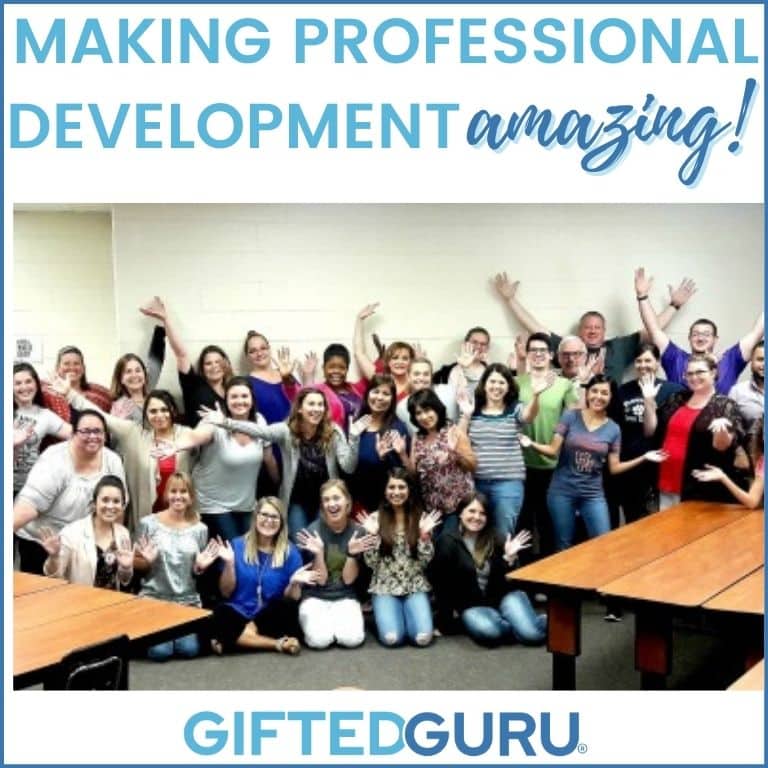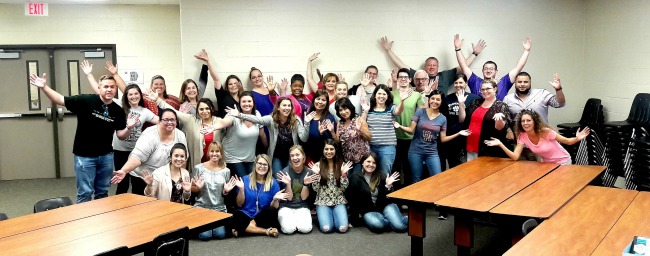
What 3 lessons did I learn from the best professional development experience in the history of the world, and how can they help you in your classroom?
At the end of June, I spent one of the most enjoyable weeks of my life in Conroe, Texas (north of Houston)…at professional development. That is not a typo.
I was facilitating a week-long gifted and talented professional development for the Conroe Independent School District, something I’ve done many times.
This week was special. More than special. Transformative.
I’m sharing three lessons I learned from the best professional development experience in the history of the world, and what I think those lessons say about teaching and learning.
Lesson 1: Plan for awesome.
I read a tweet earlier today that said you can’t know if your class is student centered in the summer because you have to wait until you have students. While I understand the sentiment, I don’t completely agree.
I was student-centered for months ahead of time, well before I ever met the teachers I’d be working with.
Prior to coming to Conroe, I planned out every way I could think of to make the training a good experience for attendees. I re-worked sessions, planned giveaways, shopped carefully for goodies, carefully considered what extra techy goodness to share, and consulted with Chris Reichelt, Conroe’s Advanced Academics mastermind, to figure out how we could make the week as wonderful as possible.
To that end, she had cool name tents ready, a great facility (with fab air conditioning because Texas), and snacks. If you feed them, happiness will come.
I thought about each day and its flow. Additionally, I thought through each day, imagining any little thing I could do to make it more awesome.
This level of planning had two effects:
- It gave me confidence that it would be a good experience. That confidence took away any worry, and anxiety is the precursor to contention (for me).
- It invested me ahead of time in the outcome. By the time the week arrived, it was very, very important to me that everyone have a good time. As the people came in, I was predisposed to like them because I had spent so much time thinking about them.
Sometimes, our planning is too shallow, mostly because of time constraints. I learned that it was worth it. It saved me time in the long run to invest time in advance because the execution was so smooth.
2. Balance the domains 50/50.
While we were there to engage in a lot of material (“Here’s everything you need to know about gifted kids, folks.”), the affective domain was equally important. The first day, the stage was set for a different level of interaction.
Chris told them all, “By the end of the week, you will be friends.”
I don’t think anyone really believed it, but it was true.
By the end of Tuesday, it was clear that something different and very special was going on. The teachers were sharing in a way that was unique and very powerful.
In addition to ideas about pedagogy and best practices, everyone was joking with each other, laughing, making connections, and truly developing relationships.
It’s more than content
Sometimes, I think I focus too much on the content and forget that the power of the connections we make. It’s silly to think that people will remember the content you teach them. They remember how they felt when they learned it, and that will play the most significant role.
As teachers, we can build in opportunities for that kind of connection. Often, we call it a class culture.
Yesterday in the grocery store I ran into the parent of two of my former students. He told me that they still talk about me (they graduated nearly ten years ago). I promise they don’t remember the Latin roots & prefixes I taught them. They remember that I loved them.
On the last day of the training with the Conroe group, one of the teachers (a brand-new, first year teacher) said, “Let’s start a Facebook group!” And we did. We’re staying connected because of the relationships built during the week, not the content.
Yet, they’ll remember the content better because of the emotional connection.
We’re also staying connected because we spent time during the week trying to matchmake one of the teachers, and we’re all hoping to be invited to his wedding! Truth. One of them is now my honorary little brother.
How can we build that kind of connection (very quickly) in our classrooms?
I love the book Good Luck, Mrs. K!, and it inspired me to try to create a strong classroom culture. In Conroe, we very quickly created inside jokes (SAT word is one of them. You had to be there.) and other connections that made it an emotional experience as well as a learning one.
What can you do to create a feeling of family, team, or whatever feeling you want in your room?
3. Learning is a binary activity.
I’m a big believer in quality teaching, great curriculum, and advanced technology, yet in order for learning to occur, the learner must be willing to learn.
All of the articles you read and blog posts and tweets and blurbs and aphorisms about Finland’s educational greatness and the necessity for teachers to be the most amazing educators ever to walk the planet and the role of quality technology and on and on ignore this core truth:
Students who do not want to learn will not learn.
We have this Pollyanna belief that if kids are loved and healthy and fed and have a great teacher, they will all crave learning.
And while I agree that children are naturally curious and will, when emotionally and physically healthy, have a natural desire to learn, by the time they get to formal school, even in very early grades, that desire is often going, going, gone.
Truly, learners have the same level of responsibility in the process as teachers, perhaps more. I can learn from even a poor teacher, but even a great teacher cannot force an unwilling learner to learn.
They brought their “A” game
In the Conroe training, the teachers were, to a person, open to learning. They were engaged. They participated in the activities. They didn’t make me compete with Instagram and Candy Crush, saving their texting and social media for the (frequent) breaks and (lengthy) lunch. They cared about serving kids. They cared about being great teachers. And that caring came through loud and clear.
As teachers, we have little control over what the students bring to the class, but we can create environments in which a desire to learn can grow and flourish.
What are some ways we can do this?
- Make sure students believe they can be successful by being very open about everyone’s possibility for success. Avoid thinking of “weeding out” students who “don’t belong” in high ability classrooms. That’s not our job. Our job is to create a feeling of anticipatory success. One way I did this was to have the rule that anyone who turned in all of their work would pass, even if every grade was a 20. In all my years of teaching, I’ve changed exactly two grades, both from 68s to 70s. Just knowing that you will for sure pass if you turn everything in helps immensely.
- Celebrate learning by not just rewarding very high grades, but rather have micro celebrations of great thinking (even just glimpses of it). My son Gregory still remembers his 7th grade science teacher’s happy dance (he’s 27).
- Clearly convey we are happy to be there. We don’t put up countdowns to vacations on the board. We don’t complain about Mondays (I know, I know). If we’re not happy to be there, they will feel it. If you’re happy and you know it, share it.
- We learn something ourselves. We share what we are learning. Taking a class? Learning how to publish a blog or book? Reading a journal or participating in a Twitter chat? Traveling to a conference? Whatever you’re doing to learn, let kids in on it. Not learning anything to share? Ummm…
When it was over
Typically, when a week-long training ends, I’m exhausted. After this training, I was invigorated.
It helped to come home to messages like this one:
I cannot express properly how wonderful the training was, but I will attempt. I am truly grateful there are people like you advocating for GT.
My expectation was an average, perhaps slightly more interesting training. Instead, I felt like Beatrice from Shakespeare, thinking “What fire is in mine ears? Can this be true?”
I was fascinated and intrigued from beginning to end. I told my boyfriend (who has gotten an earful all week, bless his heart), that you have inspired me with a new approach in pedagogy and a paradigm shift in planning lessons. As I am heading into my 19th year teaching, this is no small feat.
And this one:
I wanted to take the time to thank you again for the amazing gift of a Kindle, as well as for the amazing instruction we had all week….I think your class has helped me to kindle the passion I have for my job, and it’s given me something to look forward to as this new school year begins. I know I can speak for everyone in our class when I say how thankful we all are for your instruction.
After the training ended, I was sad for a week after it ended because I was so invested. And we can have that experience with our students, too. I hope you do. I desperately wish it for you … and them.
This is a picture of the amazing group from Conroe. Aren’t they gorgeous? I love them all.




